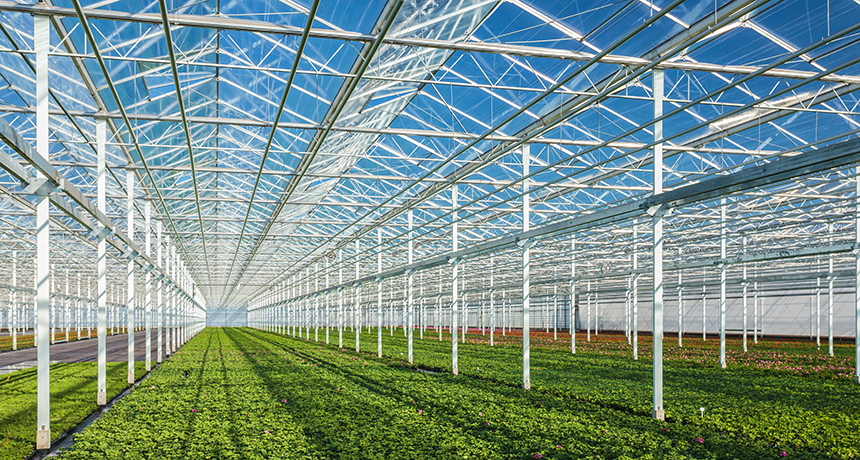How to turn a greenhouse into a powerhouse
Clear solar cells in greenhouse roofs could generate electricity while plants grow below

Greenhouses like this one could one day make their own power thanks to clear solar panels.
DutchScenery/istockphoto
Solar cells are devices that turn sunlight into electricity. This technology offers a more Earth-friendly way to produce power than burning coal and other fossil fuels. But panels of solar cells need a lot of open, sunny space to harvest that sunlight. Where space is limited, people might have to choose between solar panels and fields to grow food. But what if you could produce crops and electricity at the same time? For Yang Yang, the solution is clear. Clear solar cells, that is.
Yang is a physicist at the University of California, Los Angeles. He studies solar cells, also known as photovoltaic (Foh-toh-vol-TAY-ik) cells. Many are made using the element silicon. Yang instead works with carbon-based versions. These solar cells are known as OPVs, short for organic photovoltaics. OPVs are flexible and simple to make. Recently, several groups of scientists made OPVs that are transparent, or clear.
Because they let light pass through, one of Yang’s students suggested that they use OPVs on a greenhouse roof. This inspired Yang’s team to create and test a solar cell that could both make electricity and let enough light pass through to grow plants.
Sunlight is made up of many colors, or wavelengths, of light. The colors we see — from violet through red — are called visible light. Their wavelengths range from 400 to 700 nanometers. (A nanometer is a billionth of a meter.) Yang’s solar cells let visible light pass through, which makes them look clear. But solar cells must also absorb some light to generate electricity. Yang’s absorb infrared light, which has wavelengths between 700 nanometers and 1 millimeter. About half of the light that comes from the sun is infrared. People can’t see it, but some animals — such as snakes and bats — can sense infrared.
Plants don’t need infrared light. In fact, they need only a very small range of visible light to grow. Most plants absorb red and blue light but reflect green light. (That’s why most plants look green.) Yang’s team wanted to see whether the visible light that passes through the clear solar cells would be enough for plants to grow.
His team didn’t have enough materials to build a whole greenhouse. So they did experiments on a small scale instead. First, they put dirt into beakers and planted mung beans in them. They grew the beans in natural sunlight under three conditions. One group of beakers was uncovered. One group had aluminum foil on the sides and a clear OPV on top. Beakers in the final group were fully covered with aluminum foil to block all light.
After 13 days, the scientists looked at how well the seeds had sprouted. In the foil-covered beakers, plants grew poorly. But seeds with a clear solar cell on top grew about as well as seeds in uncovered beakers. That means the solar cells might work on the roof of a greenhouse.
The team published its findings online January 3 in ACS Nano.
Room for growth
Whether enough light can pass through a solar cell isn’t the only feature scientists need to think about. There’s also efficiency. Common rooftop solar cells, which absorb visible light, have an efficiency of about 18 percent. That means they produce 18 watts of power for every 100 watts of sunlight they absorb. Yang’s test OPV has close to 10 percent efficiency, which is still quite good. “But our lab’s cell is very small,” Yang says. “When the solar cell is made with a large area, the efficiency typically drops a little bit.”
Yang thinks greenhouses might become more popular for farming in the future. As climate change makes growing conditions less predictable, greenhouses could give farmers more control. Yang’s team would like to “turn the greenhouse into a powerhouse to generate electricity,” he says. “That would be very useful.”
But for people to use this technology on a wide scale, “everything comes down to cost,” he adds. “Right now, this technology is very expensive.” Yang hopes that one day a large company would be willing to mass-produce the technology. That might help to drop its cost.
Luis Campos thinks using the solar cells for both power generation and farming is clever. A chemist, he works at Columbia University in New York City. Because most solar cells absorb visible light, only transparent OPVs like Yang’s could be used for this purpose. “It is certainly exciting to see the multiple applications that renewable energy devices can serve,” he says.
Campos shares Yang’s concern that bigger versions of the cells might not work as well. Making devices larger can create new challenges, he says, and their efficiencies can fall. Still, he finds Yang’s use of solar cells “an impressive accomplishment.”
When today’s students grow up, Yang hopes some of them will help make this type of technology better and less costly. That would boost its appeal and potential uses. “Science is fun and a challenge,” he says, “and I hope the young kids will join us.”







